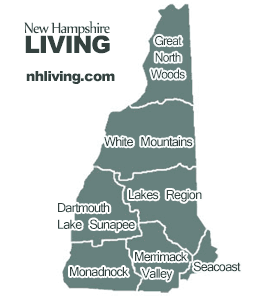History of New Hampshire Maple Sugaring
NH Maple Syrup – Maple Products – Maple Producers
 The NH maple sugaring season usually starts about mid-February and ends around mid-April. How well and long the season is depends greatly on the weather. New Hampshire Maple Producers usually produces about 90,000 gallons of maple syrup in a given season. Considering that it takes forty gallons of sap to make one gallon of syrup that is alot of sap.
The NH maple sugaring season usually starts about mid-February and ends around mid-April. How well and long the season is depends greatly on the weather. New Hampshire Maple Producers usually produces about 90,000 gallons of maple syrup in a given season. Considering that it takes forty gallons of sap to make one gallon of syrup that is alot of sap.
Maple syrup grades vary depending on the tree and the time of season you are tapping. The tap made early in the season generally produces a Grade A Fancy Syrup – the lightest shade and most delicate flavored Maple Syrup. Sap gathered later in the season tends to produce a heartier Grade B Maple Syrup. Ask us about NH Maple Products or share your comments. To feature your local products or business, contact us.
New Hampshire Maple Sugaring History & Products

Polly's Pancake Parlor, 672 Route 17, Sugar Hill, NH 03585 | 603-823-5575
Polly's Pancake Parlor has been serving yummy home cooked meals for over 75 years. Enjoy a stack of Oatmeal Buttermilk, Buckwheat or Whole Wheat pancakes. Sit back and savor a waffle of your choice smothered in real New Hampshire maple syrup or come for lunch and have a slice of quiche made with local Harman's cheese. Shop for gifts, pancake mixes and NH Maple Syrup. Reservations taken on weekends.
Visit Polly's Pancake Parlor - Sugar Hill, NH
HISTORY OF MAPLE SUGAR AND MAPLE SYRUP AS A FOOD
The first people to make maple sugar were the Native American tribes of the Northeast, who used it as a flavoring for breads, stews, teas, and vegetables. Native Americans also traded maple sugar for other products they needed. The French and English colonists were delighted with the taste of maple sugar, and eventually, they learned the process of making it from the Native Americans. Maple sugar became the principal sweetener in North America. (Native Americans and colonists could not store maple syrup easily, so they used the dry form.) When cane sugar was introduced, New Englanders still preferred maple sugar because it was much cheaper and did not involve West Indian slave labor.
Once a staple of American life, the sweet products of the maple tree are now specialty items. Over the years, the price of cane sugar fell dramatically, and now cane sugar is the variety most Americans use every day. The popularity of maple syrup keeps Vermont sugarhouses going. As anyone who has ever tasted it knows, genuine maple syrup has a taste and texture that the imitations just cannot match. (In Quebec, cheap imitation maple syrup is called “sirop de poteau” or “pole syrup”, suggesting that it was made by tapping telephone poles. We couldn’t agree more.)
PRODUCTION OF MAPLE SUGAR AND MAPLE SYRUP
When the weather conditions are right, sugarmakers will head into their stand of trees, usually called maple orchards or sugarbushes, in late February and begin drilling small holes into the trunks of their maple trees. If all goes well, a clear, slightly sweet liquid will slowly drip from the spiles into buckets or into a pipeline that will carry the sap to a central collection point.
The highest quality syrup is made from the freshest and cleanest sap. If not immediately tended, the sap will deteriorate and the resulting syrup will not meet maple connoisseurs’ high standards. Vermont sugar shacks house huge evaporator pans fired by wood, oil, or gas to heat the sap to the boiling point. Billows of steam escape through a vent or cupola atop the shack, where the aroma travels on the air for all to enjoy.
It takes long hours and perseverance to produce Vermont maple syrup worthy of the name. The boil-down process is especially tedious, continuing for hours in order to eliminate all water content from the sap. Once the boiling process is complete, the delectable golden brew is filtered and packed for distribution to eager consumers around the world. The Vermont Department of Agriculture administers stringent quality requirements on the making and selling of Vermont maple products. By state law, all containers of maple syrup sold in stores must have a label giving the grade of the syrup and the name of the producer.
CHANGES IN MAPLE SYRUP PRODUCTION METHODS
Because maple syrup is a natural product, the process of making it has changed little over the centuries. The main improvements have been in the materials used for collecting and boiling the sap. Native Americans had cut slashes in the trees and collected the sap in containers made of bark or hollowed-out logs. Colonists were concerned that slashing the trees with axes harmed the trees, and they began drilling small holes into the tree and inserting a wooden tube. The tube allowed the sap to flow out.
The process of collecting the sap with buckets was quite time-consuming. Over time, people began to use horses, oxen, or tractors to haul the sap to the sugarhouse. Most modern sugarmakers use plastic tubes to carry the sap from each tree to a central location. Plastic tubes also protect the sap from dirt and bacteria.
New materials have also made the process of boiling the sap more efficient. The Native Americans had used hot rocks to heat the sap. Colonists used wood fires and kettles made of cast iron, a material they had brought with them from Europe. In the late 1800’s, people began using flat-bottomed tin pans instead of iron kettles because they provided more even heat. Recently, many sugarmakers have replaced their wood-fired evaporators with ones that use oil.
Maple Facts | Maple Houses | Maple Grades
NH Maple Producers by Region

Discover NH Maple Products in every region. Great North Woods, White Mountains, Lakes Region, Dartmouth-Sunapee, Monadnock, Merrimack Valley and Seacoast.
Great North Woods NH Maple Products
Berlin, Colebrook, Errol, Dixville, Lancaster, Pittsburg
White Mountain NH Maple Products
North Conway, Lincoln, Woodstock, Littleton, Franconia, Gorham, Jackson, Sugar Hill, Whitefield, Waterville Valley
Lakes Region NH Maple Products
Laconia, Rochester, Plymouth, Ossipee, Meredith, Ashland, Wolfeboro, Bristol, Winnipesaukee
Dartmouth Lake Sunapee NH Maple Products
Lebanon, Hanover, Claremont, Newport, Tilton, Lyme, Plainfield, Newport
Monadnock NH Maple Products
Keene, Peterborough, Fitzwilliam, Westmoreland, Chesterfield
Merrimack Valley NH Maple Products
Manchester, Concord, Nashua, Salem, Derry, New London, Merrimack, Loudon
Seacoast NH Maple Products
Portsmouth, Dover, Durham, Hampton, Exeter, Rye, Hampton Beach
Maple History | Maple Facts | Maple Grades
NH Lodging Guide | Weddings
Products | NH Town Guides
Free World Mall
Country Weddings | New England Recipes
Paradise Coast Living | Boston Red Sox Gifts
Vermont Living | ME Living | MA Living






